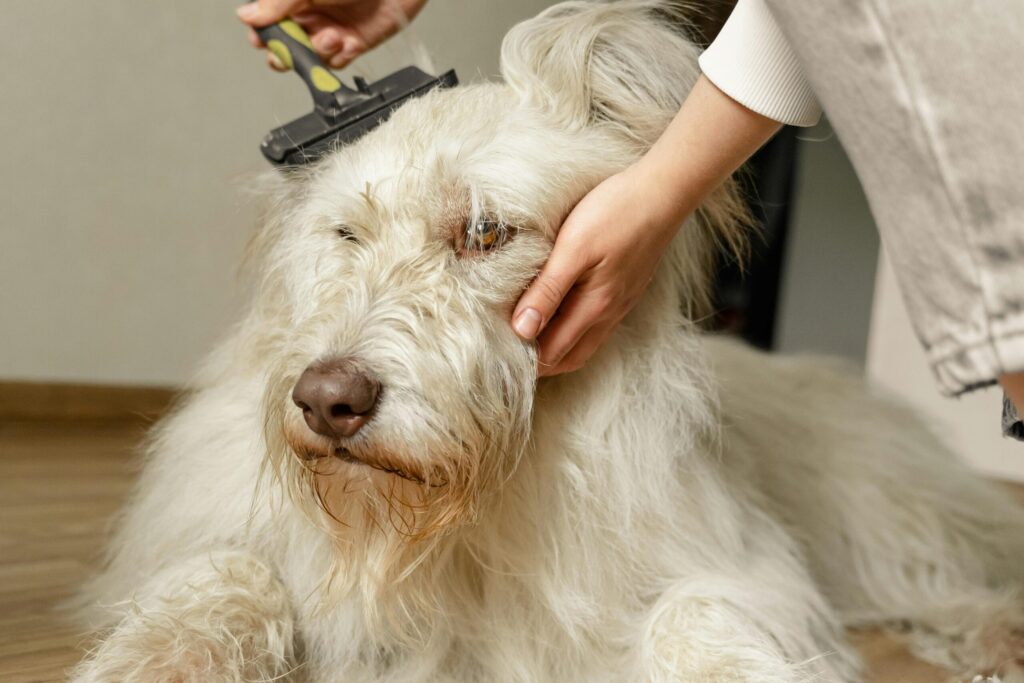Introduction
Dog shedding is a natural and ongoing process in which dogs shed old or damaged fur to make way for healthier new hair. While shedding is normal, excessive shedding can be overwhelming, leaving fur all over the home and potentially signaling health issues. This comprehensive guide delves into professional grooming techniques, effective brushing methods, the role of nutrition and supplements, bathing routines, and practical home cleaning tips that together provide a full-spectrum solution for managing dog shedding.
Understanding Dog Shedding
Shedding occurs as part of a dog’s hair growth cycle and varies widely by breed, coat type, season, diet, stress, and health. Double-coated breeds such as Huskies, Golden Retrievers, and German Shepherds shed heavily twice a year during “coat blow” seasons (spring and fall). Single-coated or low-shedding breeds shed less but still lose fur incrementally. Sudden or excessive shedding may indicate allergies, infections, parasites, hormonal imbalances, or nutritional deficiencies and should prompt veterinary evaluation.
Professional Grooming Techniques to Reduce Shedding
Professional groomers utilize specialized tools and protocols beyond typical home grooming:
- De-Shedding Tools: Tools like the FURminator and undercoat rakes penetrate deep into dense coats to remove loose undercoat fur that regular brushes can’t reach.
- Blow Drying: High-velocity blow dryers loosen and remove loose hair post-bath, reducing indoor shedding.
- Shed Control Treatments: Multi-step grooming treatments include thorough brushing, specialized shampoos, conditioning treatments, and blow-outs that significantly reduce shedding by removing dead hair at the root.
- Seasonal Grooming Adjustments: Groomers tailor their approach based on shedding cycles to effectively manage thick fur loss without damaging the coat.
- Avoiding Shaving: For double-coated breeds, shaving disrupts natural insulation and moisture control; professional grooming focuses on thinning rather than removal.
Daily and Weekly Brushing Hacks
Daily brushing is the cornerstone of home shedding control:
- Choose brushes tailored to your dog’s coat (slicker brushes for long-haired, bristle brushes for short-haired, grooming gloves for sensitive coats).
- Brush in the direction of hair growth, starting at the skin to loosen undercoat fur.
- Use de-shedding tools once or twice weekly for heavy shedders.
- Groom outdoors when possible to minimize indoor fur scatter.
- Grooming gloves can work well for anxious or sensitive dogs, providing tactile stimulation and fur removal.
Supplements and Nutrition for Shedding Control
What your dog eats internally affects the health of their coat and shedding:
- Omega-3 and Omega-6 Fatty Acids: Found in fish oil and flaxseed, these reduce inflammation, moisturize skin, and promote a glossy, resilient coat.
- Zinc, Biotin, and Vitamin E: Support hair strength and reduce brittleness.
- High-Quality Protein: Integral for new hair growth and coat repair.
- Always consult a veterinarian before starting new supplements to optimize dosage and safety.
Bathing and Grooming Products
Proper bathing complements brushing:
- Use deshedding shampoos and conditioners formulated to soothe skin and remove loose hair. Ingredients like oatmeal, aloe vera, and essential fatty acids help moisturize and calm irritated skin.
- Avoid overbathing to prevent skin dryness that worsens shedding — typically every 4 to 6 weeks suffices.
- Consider rinse-free shampoos between baths for a quick clean and coat refresh.

Home and Environment Cleaning Tips
Keeping your living space fur-free requires consistent cleaning:
- Vacuum frequently with pet-specific attachments that capture hair from carpets, upholstery, and floors.
- Use lint rollers or rubber gloves on clothing and furniture to collect fur.
- Wash pet bedding regularly to reduce fur accumulation.
- Air purifiers with HEPA filters help reduce airborne hair and dander, especially during shedding seasons.
Hydration, Stress Reduction, and Wellness
- Ensure your dog has constant access to fresh water because dehydrated skin can exacerbate shedding.
- Reduce stress through play, exercise, and maintaining consistent routines, as stress-related shedding is common.
- Regular veterinary check-ups can catch infections, allergies, and hormonal imbalances early.
Why Professional Grooming is Essential
Professional groomers bring expertise, tools, and techniques unattainable by most owners:
- They can remove mats that trap shedding fur and cause discomfort.
- Early detection of skin problems or parasites during grooming benefits overall health.
- Tailored grooming helps maintain coat integrity while aggressively minimizing shedding.
- Grooming salons use powerful dryers to strip loose fur inaccessible by brushing alone.
Summary
Managing dog shedding requires a multi-layered approach combining proactive professional grooming, daily home brushing, proper nutrition, and environmental housekeeping. Employing specialized grooming techniques and high-quality diet supplements improves coat health and reduces shedding at the source, while regular cleaning keeps your home fur-free. By addressing shedding from inside out, dog owners create a more comfortable environment for their pets and themselves, enjoying a healthy, happy dog with a beautifully maintained coat.



